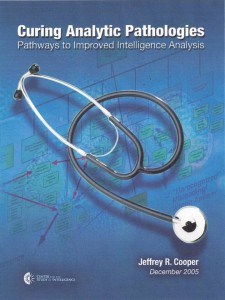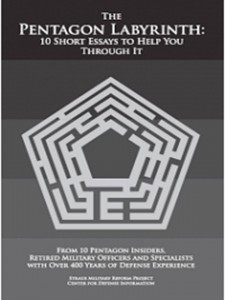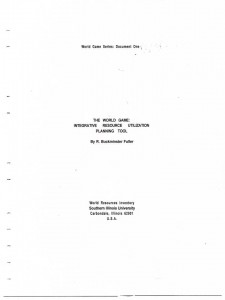
Handbook: Curing Analytic Pathologies
AnalysisHandbook: How to Negotiate a Ceasefire
Law Enforcement, Military, Stabilization, Threats/Topical, UN/NGO Kristan Wheaton posted the below to his blog yesterday:
Kristan Wheaton posted the below to his blog yesterday:
How To Negotiate A Ceasefire (HDCentre.org)
The Centre For Humanitarian Dialogue, located in Geneva, Switzerland, has done a really good job of pulling together a concise monograph called “Negotiating Ceasefires”.
Only 44 pages from start to finish (including endnotes and a comprehensive list of suggested additional readings), this guidebook is filled with practical advice, concise case studies and quotes from practitioners about the risks and rewards inherent in negotiating a ceasefire.
Reference: The Pentagon Labyrinth
6 Star Top 10%, Banks, Fed, Money, & Concentrated Wealth, Budget Process & Politics, Capitalism (Good & Bad), Complexity & Catastrophe, Congress (Failure, Reform), Corruption, Crime (Corporate), Crime (Government), Culture, Research, DoD, Economics, Empire, Sorrows, Hubris, Blowback, Executive (Partisan Failure, Reform), Force Structure (Military), Historic Contributions, Impeachment & Treason, Intelligence (Public), Justice (Failure, Reform), Media, Military, Military & Pentagon Power, Misinformation & Propaganda, Monographs, Peace, Poverty, & Middle Class, Politics, Power (Pathologies & Utilization), Priorities, Public Administration, Science & Politics of Science, Secrecy & Politics of Secrecy, Security (Including Immigration), Threats (Emerging & Perennial), True Cost & Toxicity, Voices Lost (Indigenous, Gender, Poor, Marginalized), War & Face of BattleIt is my pleasure to announce the publication of The Pentagon Labyrinth: 10 Short Essays to Help You Through It. This is a short pamphlet of less than 150 pages and is available at no cost in E-Book PDF format, as well as in hard copy from links on this page as well as here and here. Included in the menu below are download links for a wide variety of supplemental/supporting information (much previously unavailable on the web) describing how notions of combat effectiveness relate to the basic building blocks of people, ideas, and hardware/technology; the nature of strategy; and the dysfunctional character of the Pentagon’s decision making procedures and the supporting role of its accounting shambles.
Chuck Spinney
The Blaster
This pamphlet aims to help both newcomers and seasoned observers learn how to grapple with the problems of national defense. Intended for readers who are frustrated with the superficial nature of the debate on national security, this handbook takes advantage of the insights of ten unique professionals, each with decades of experience in the armed services, the Pentagon bureaucracy, Congress, the intelligence community, military history, journalism and other disciplines. The short but provocative essays will help you to:
- identify the decay – moral, mental and physical – in America’s defenses,
- understand the various “tribes” that run bureaucratic life in the Pentagon,
- appreciate what too many defense journalists are not doing, but should,
- conduct first rate national security oversight instead of second rate theater,
- separate careerists from ethical professionals in senior military and civilian ranks,
- learn to critique strategies, distinguishing the useful from the agenda-driven,
- recognize the pervasive influence of money in defense decision-making,
- unravel the budget games the Pentagon and Congress love to play,
- understand how to sort good weapons from bad – and avoid high cost failures, and
- reform the failed defense procurement system without changing a single law.
The handbook ends with lists of contacts, readings and Web sites carefully selected to facilitate further understanding of the above, and more.
Journal: Human Intelligence (HUMINT) Successes
08 Wild Cards, 09 Terrorism, 10 Security, 10 Transnational Crime, Government, HUMINT, IO Multinational, IO Secrets, IO Sense-Making, Law Enforcement, Military, Peace Intelligence
(1) If true, probably a good idea.
Miami Herald November 6, 2010
Spy Agencies Use Ex-Captives To Infiltrate Al Qaeda
By Paisley Dodds, Associated Press
LONDON — Months after he was released from Guantánamo Bay, Abdul Rahman was back in the company of terrorist leaders along the Pakistan-Afghanistan border. But he was a double agent, providing Taliban and al Qaeda secrets to Pakistani intelligence, which then shared the tips with Western counterparts.
The ruse cost him his life, according to a former Pakistani military intelligence official, Mahmood Shah. The Taliban began to suspect him, and after multiple interrogations executed him.
The case of Rahman, which Shah recounted to The Associated Press, falls in line with a key aspect of the fight against terror — Western intelligence agencies, with help from Islamic allies, are placing moles and informants inside al Qaeda and the Taliban. The program seems to be bearing fruit, even as many infiltrators like Rahman are discovered and killed.
It was a tip from an al Qaeda militant-turned-informant that led international authorities to find explosives hidden in printer cartridges from Yemen to the United States a week ago, Yemeni security officials say. Officials say the explosives could have caused a blast as deadly as the Lockerbie bombing that killed 270 people.
Phi Beta Iota: Human Intelligence (HUMINT) done right, in the context of Open Source Intelligence (OSINT) done right, is the cheapest, fastest, and most effective means of creating intelligence (decision-support) at all levels from strategic to tactical. After ten years of letting CIA get away with doing both badly, and ten years of the Pentagon's recovering from treating its HUMINT and CI people like shit, it appears that adults are finally back in charge. We continue to under-budget for operational HUMINT and OSINT, and we continue to grossly over-spend on contractor vapor-ware for technical capabilities that simply do not deliver 96% of what what we need, but that is a separate issue. It is good to see HUMINT (not OSINT) making some progress. However, the continued absence of a strategic analytic model and honest governance means that these capabilities are not being focused on transnational crime or on white collar crime, where the most significant gains in the public interest are to be achieved.
See Also:
2010: Human Intelligence (HUMINT) Trilogy Updated
2009 DoD OSINT Leadership and Staff Briefings
Graphic: OSINT and Full-Spectrum HUMINT (Updated)
Graphic: OSINT and Lack of Processing
Graphic: Four Quadrants J-2 High Cell SMS Low
Graphic: Human Intelligence (HUMINT) 101 (Wrong Way)
Graphic: Human Intelligence (HUMINT) 102 (Right Way)
Search: Handbook First Earth Battalion Field Manual
Historic Contributions, HUMINT, Officers Call, Searches, Stabilization, UN/NGO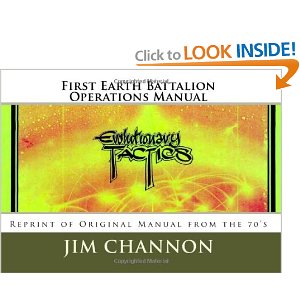
This Handbook entry is inspired by the search <first earth battalion operations manual>. We really appreciate searches of this nature, as they cause us to add entries that *should* be here. Thank you for the search.
First Earth Battalion Home (Current!)
Wikipedia Page First Earth Battalion
First Earth Battalion Field Manual Free (Display & PDF for Print or Download)
2014 Handbook Online for Internet Tools and Resources for Creating Open Source Intelligence (OSINT) by Dr. Ran Hock, Chief Training Officer, Online Strategies, Inc.
Historic Contributions, IO Tools, OSINT Generic
PLATINUM LIFETIME ACHIEVEMENT, Dr. Ran Hock
Dr. Ran Hock has done more than any single individual to educate both government and private sector parties with respect to the value of the deep web. He has single-handedly trained hundreds of individuals in the nuances of this major new intelligence resource base. Emphasizing individual analytic skills and common sense rather than arcane expensive and generally unproductive technologies, he represents the intersection of integrity, intelligence, and intuition in the service of all legitimate governments and organizations.
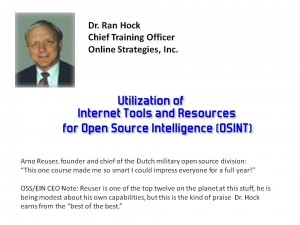
The blurb from Arno Reuser, founder and chief of the Dutch military open source intelligence division, says essentially that attending Ran Hock's course once a year made him look smart for the entire year. Arno is a master librarian and a giant in the field, he is being modest, but this is the kind of praise that Ran Hock's earns from the “best of the best.”
See Also:
- Handbooks(64)
- Analysis (13)
- C4/JOE/Software (4)
- HUMINT (11)
- Law Enforcement (12)
- Military (19)
- OSINT Generic (17)
- Stabilization (19)
- Threats/Topical (13)
- UN/NGO (19)

